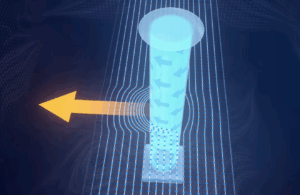What makes Boston University’s indoor track so fast?
Two-and-a-half miles from BB&N lies Boston University’s indoor, 6-lane, 200-meter track (1). Often referred to as the “Launchpad,” this indoor track is arguably one of the fastest indoor tracks to run on in the world (2). Today, athletes are flocking to BU’s facilities to experience the unreal speeds for themselves. What makes this indoor track so unbelievably fast?
Boston University’s indoor track attracts a diverse body of spectators to spectate record-breaking runs.
BU’s track is banked, meaning the surface is tilted inwards on the turns (1). The 18-degree sloped banks allow runners to round the turn without losing energy due to centripetal forces, which are necessary for turning while moving at a constant velocity (1, 3). Centripetal force is the “acceleration of continuously changing the direction of the given speed as the object rotates around the turn” (3). In the case of running around an oval track, centripetal forces pull runners outward, away from the track, as they round the turns (1). If not corrected for, this force causes runners to both lose speed and energy from the effort of trying to remain upright.
The centripetal force in running is derived from the mediolateral friction, or the friction in the forefoot of a shoe that is the result of the foot’s side-to-side movements (3). Mediolateral friction is proportional to the square of the running speed and inversely proportional to the radius of the turn (3). Put simply, the faster you run, the more centripetal force is needed to round the turn, and the larger the turn radius, the less force is needed (3).
However, centripetal force and mediolateral friction are not the only factors at play when it comes to record-breaking races. The tilted, banked turns alter the angle of the normal force—the force that the ground applies back to an object it is touching—as well (3). Typically, normal force is angled straight upward, perpendicular to the flat ground. A banked surface means that the normal force is also tilted (3).
Therefore, instead of runners solely experiencing centripetal forces as they round the turn, the total force the runner encounters is the sum of the force perpendicular to the ground and the tilted normal force from the banked surface (3). By increasing the tilt of the bank, more of the normal force is directed inward. In contrast, on a flat track, runners utilize friction to turn (3). The runner must exert additional force in the opposite direction they’re turning in order to stay upright, consequently causing them to lose energy (3). A banked track eliminates this factor when a runner races at the optimal speed for the bank and turn, thus no lateral force is necessary to run the turn (3).
What sets BU’s indoor track even farther apart from many collegiate running facilities is a technique called “asymmetric” banking (4). While most indoor tracks employ “symmetric” banking techniques, where the track rises to its highest point in the middle of the turn, slowly dropping off as the runner reaches the straightaway, “asymmetric” banking rises to the maximum bank angle early into the turn and remains consistent throughout 75% of the turn before dropping off into the straightaway (4). This innovation is supposedly less disruptive to the runner’s stride than a constantly-changing bank angle (4).
The frame of the track itself is built from wood covered with rubber-coated plywood, a more compliant (less firm) surface than a banked track built on a traditional metal frame (4, 1). On a noncompliant (firm) surface like metal or asphalt, our bodies behave like giant springs; our joints also travel through larger ranges of motion, reducing stiffness (4). Compliant surfaces stiffen our joints, thus reducing our range of motion, which correlates to better efficiency (4). However, even if compliant, a surface that “dampens,” or doesn’t return the energy put in, forces runners to work against the surface, and consequently decreases efficiency (4). The optimal surface is both compliant and resilient, returning the energy put in (4).
In the past few years, many records have been set at the BU indoor track, including Yomif Kejelcha’s historic 3:47.01 mile in 2019 (1). The track’s so-called “superpowers” have put BU on the international running map, attracting runners of all abilities to both compete and spectate (5). There is no doubt that in the future, there will be more records broken within the electric atmosphere of BU’s unique indoor track.
Bibliography:
- Kimball, J. (2023, March). Video: The Mystery behind BU’s Record-Breaking Indoor Track. Boston University; BU Today. Retrieved from https://www.bu.edu/articles/2023/why-is-bu-fastest-indoor-track/#:~:text=It%20starts%20with%20physics.,the%20outside%20of%20the%20track
- Boston University Athletics. (2024, July 22). Track & Field Announces Indoor Home Meets Schedule. Boston University Athletics. Retrieved from https://goterriers.com/news/2024/7/22/mens-track-field-track-field-announces-indoor-home-meets-schedule.aspx
- in. (2018, March 8). GB. GB. Retrieved from https://www.geoffreyburns.com/stream/theres-money-in-the-bank-the-physics-of-indoor-track-and-optimal-speeds
- be. (2022, February 20). GB. GB. Retrieved from https://www.geoffreyburns.com/stream/it-pays-be-to-be-compliant-the-physics-of-indoor-track-and-optimal-surfaces#:~:text=They%20termed%20this%20%E2%80%9Cthe%20cost,sport%20as%20we%20know%20it.
- Mull, C. (2024, March 28). BU Has Become An Essential Racing Destination. Here’s Why. – FloTrack. FloTrack; FloSports. Retrieved from https://www.flotrack.org/articles/12372583-bu-has-become-an-essential-racing-destination-heres-why
Images:







Comments are closed.